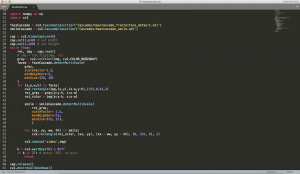Team Update
The most significant risks that could jeopardize the success of our project to our current knowledge include:
- the narrow range of the thermal camera sensors, which might not be able to accurately detect humans in all directions
- the speed and accuracy of the face detection when run on the raspberry pi, must be fast enough to capture an image before it moves out of the frame
Risk management and contingency plans:
- We have not received the thermal camera sensors, but we have talked to some TAs and peers. After receiving them and testing them, we may simply add a fish-eye or wide-eye lens to the camera which should help. In addition, our TA has informed us that there are ultrasonic sensors available for this class. We plan to test those since it won’t place a dent in our budget, and may even end up using some of those.
- We have begun experimenting with opencv and different libraries for face detection on a laptop. By using haar cascades, the face detection works with minimal lag in real time, although we will need to do further testing when we port the code to our rpi.
Since we have not received all of our parts and have not started assembly or programming specifically for our design, we have not needed to make any changes to our existing design. We have obtained a roomba and have received our Raspberry Pi. The thermal camera sensor we ordered has just come in, so we will pick that up from the office this next week when it’s open. Our current plan of action is to continue ordering parts for the original design.
Cornelia
This week, our group spent a long time researching the exact parts we want and the sites with the cheapest prices to purchase from. Then, we placed orders for them together and have just started receiving a few of them. In addition, I helped Mimi look into OpenCV and test the library’s capabilities for face detection. We thought about the ways we can utilize existing projects’ implementations and changes we need to make to account for our own specifications such as needing the face-detection box to be bigger than the face detected so no one’s face has a chance of ever getting cut off.
I also started looking at documentation for the Roomba library pyCreate2 since I will be programming the Roomba to move. This GitHub repository also seems helpful. It lists all the sensors on the Roomba and the range of values it works with. It also shows you how to set up and use the library. I will be using these documentations a lot to program the Roomba.
According to the Gantt chart we created for our team, I am right on schedule. This week, once the Raspberry Pi has been set up with its OS, I will begin programming the roomba to move.
This upcoming week, the deliverable I hope to complete is making the roomba move in at least the 4 basic directions: forward, backward, left, and right. From there I will make expand the movements to hopefully all 360 degrees of direction.
Mimi
This week I worked on learning about opencv and how to perform real time face detection. I downloaded opencv onto my computer and tested out some existing libraries for face and smile detection using my webcam. The code I used for testing is here:

This week I also acquired our roomba for our project, and put in orders for a thermal sensor and camera to go with the raspberry pi. Lastly, I read and did the first reading reflection for the class.
My progress is on schedule according to our Gantt Chart that we created.
In this coming week, I will move the code I’ve written to the raspberry pi to test it. In addition, I will be working on writing code to trigger image capture when faces are detected, using the raspberry pi and the camera we ordered.
Adriel
This week, I’ve begun installing the Raspbian operating system onto the Raspberry Pi. There was a little bit of time delay between when I received the Pi and when our Pi was ordered so I haven’t completed the installation at the time of this post. I fully expect to have it installed either by tomorrow (Sunday) or Monday, so that our team will have a platform to upload code onto by our next group meeting (Tuesday). IN the meantime, I have also been doing more research about how the Pi communicates with the cameras, in an attempt to make the transition as seamless as possible.
Is your progress on schedule or behind? If you are behind, what actions will be taken to catch up to the project schedule?
So far, this progress is behind schedule, mainly because it took awhile for me to receive the Pi. I do not see this being a problem and will make sure my tasks get completed at least before our next group meeting.
Next week, I hope to have the Pi completely configured, and have the Pi camera attached.